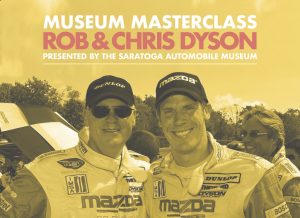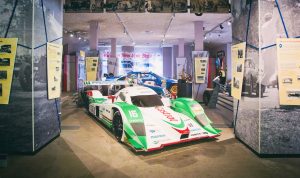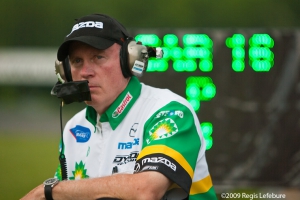Rob Dyson started racing in 1974 – in a hand-built Datsun 510. Last year Dyson Racing won five championships: the American Le Mans Series LMP1 Driver, Team, Engine Manufacturer (Mazda), and Tire (Dunlop) Championships along with the Michelin Green-X Challenge. In between, Rob Dyson and Dyson Racing has been a stalwart force in prototype racing, fielding one of the most successful teams in endurance racing. Here is the second of a three-part in-depth interview with team principal, Rob Dyson:
The 24 Hours of Daytona holds a special place in your heart – what makes it so unique as a driver and team owner?
“It was always a thick book full of blank pages – as the race wore on you made it happen. It was a thick book that had to be filled and it was filled with so many different chapters. As with any 24-hour race, when you have different classes of cars, you had to keep your head about you. It was such a mammoth event and so much was run in the dark and cold. Le Mans was a different type of 24-hour race – it never really got as dark or cold. Daytona has a great history with iconic drivers and cars and great battles. It is one of racing’s great events. I look back at our wins there in ’97 and ’99 as some of the great wins for Dyson Racing.”
What makes a person a “racer”
“It is a person who is there to compete. A guy who is a racer is born with it. It is the guy who wants to pound that fastball coming across the plate into the center field seats. That same kind of analogy works for a racer: you want to succeed, you want to compete and you want to win. You may not always win, but you sure want to win above all else.”
What do you look for in a driver?
“I think one of the biggest things is they have to have an overriding passion for racing. This is not a passive sport where you can show up and play out your option before you go on to your broadcasting career. You have to eat, drink and live it. Racing has to put you on the edge of your seat. Then there are the physical requirements – you have to be fit and ready to go the distance in the car. Plus every driver who has been with Dyson Racing understands that you are a part of the team, you are not the team. Even when you are not at the race track, you are still part of the team.
“It is kind of interesting. I will get asked who is the most important guy on the team and I will say it is David Fryer, Matt Charland and Roy VanVoorhis. These are the guys that drive the trucks that get the cars to the racetrack. If they do not do their job, we are not able to do our job. You have to put it in perspective – everyone has their job – and they are all part of the team and that is what our drivers understand when they come to this operation: it is absolutely a team sport.”
If you had not gotten involved in racing, is there any other sport you would have become involved in?
“I don’t think so. Racing was just a natural extension. Long before I was a teenager, I was working on internal combustion engines. I was always a car guy. When the new models would come out each year, my mother would take me down to the dealerships to check them out. In those days the Mercurys and the Pontiacs were the hot cars. You would see the new sedans at the Pontiac agency that they where making stock cars out of. You would go to the Chevy dealership and there would be the new Corvettes with the 283 V8 engine in them, and they even had a fuel-injected model. And it was just a natural part of the thrill of being a car guy. I don’t remember having the desire to do anything else or was involved in any other sport that was as emotionally satisfying.”
Why does Dyson Racing have a history of hiring local people?
“The simple answer is because it works. You get guys that bring their talent with them plus they know the area and they know the local vendors and suppliers. Plus when you hire locally, you have team members who are committed to the area and already have roots here and more dedicated to the idea of working long-term for Dyson Racing. When you hire from other teams, sometimes you get people that bring their bad work habits with. Out team is as much a family as a team and I am always concerned about people bringing in negative attitudes and affecting the positive dynamics of our team. Dyson racing is a very cohesive family and works very well that way.”
Best part of being a race car driver?
“Being part of a team and being involved in a competitive environment is very stimulating. Getting the most from the car, the satisfaction of taking all of the work of your team and turning it into results. There is a single-minded focus on the job at hand and great pleasure at the outcome when you do well.”
Best part of being a team owner?
“I think it is watching the guys working together as a team. Giving them an environment that everyone wants to be a part of and everyone wants to succeed and they are going to do everything they can to make it happen. Being involved in racing taps into everything I that I enjoy and find interesting and challenging.”
What was the 24 Hours of Le Mans like as a driver?
“In those days, you had the long Mulsanne straight and you had sixty seconds every two and a half minutes to contemplate your mortality. It was an interesting experience – they started changing the course the next year, but back than the approach to the esses was super-quick and you had the Mulsanne straight with no chicanes. It was neat, especially at night in the rain. Le Mans is a race more than most, where you had to blank out all the other things and focus exclusively on the job at hand. It was a real car race in the proper sense of the word. You were doing 220 mph on everyday roads. I was very appreciative that I had the chance to do it. I had several opportunities to race there again in good equipment, but I passed them up. The experience was so extraordinary and so important that I said I would not do it again. I did it once, and finished in the top ten. I was actually on the racetrack at the end for the last two hours, so I got to witness what happens at the end of the race when all the fans come out and mob the track. The last twenty minutes of the race I had a hard time seeing what with the emotion of the event. I was savoring the fact that I was in an iconic race I use to read about in Sports Car Graphic and Road &Track. It was a terrific event and I am glad I went there and experienced the race and all the spectacle.”
What was your best race?
“Actually I think it might have been a regional SCCA race at Lime Rock Park in 1975. I lost virtually all my brakes during the race. I stayed in the car and developed a smooth rhythm using the gearbox and what little stopping power I had left. Think that was one of my better races. I had a lot of great GTP races. I fondly remember the two races I had with A.J. Foyt at Miami and Sebring. There have been so many races; it is hard to pick just one. Basically, I would always try to do a workman like job at every race. That was the object – make sure you laid the laps down and did the best you could every lap.”
Any single best memory in racing?
“I remember going to Indianapolis in 1962 and having a pass to go in the garage area. Being able to see the cars close up was such a mammoth memory. Seeing the big beautiful facility and seeing the cars with their chrome exhausts and metal flake paint and open wheel suspensions. And walking among such famous drivers. As a kid, the best thing I ever worked on was a beat up old jalopy and to see the state of the art racing machines and meet A.J. Foyt – A.J. had won the championship and the 500 the year before. Experiencing all this was a phenomenal experience and an epiphany – I wanted to be a part of it all.”


